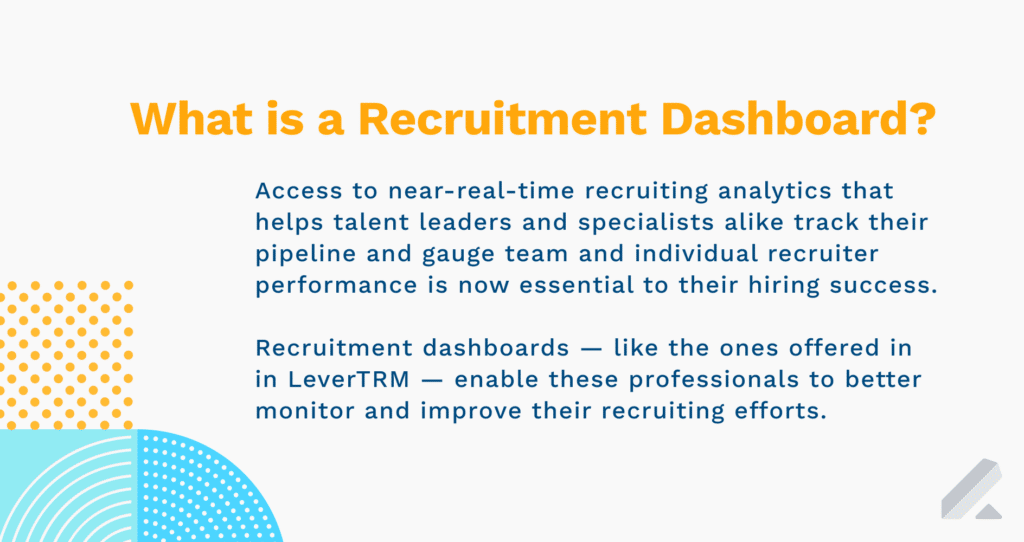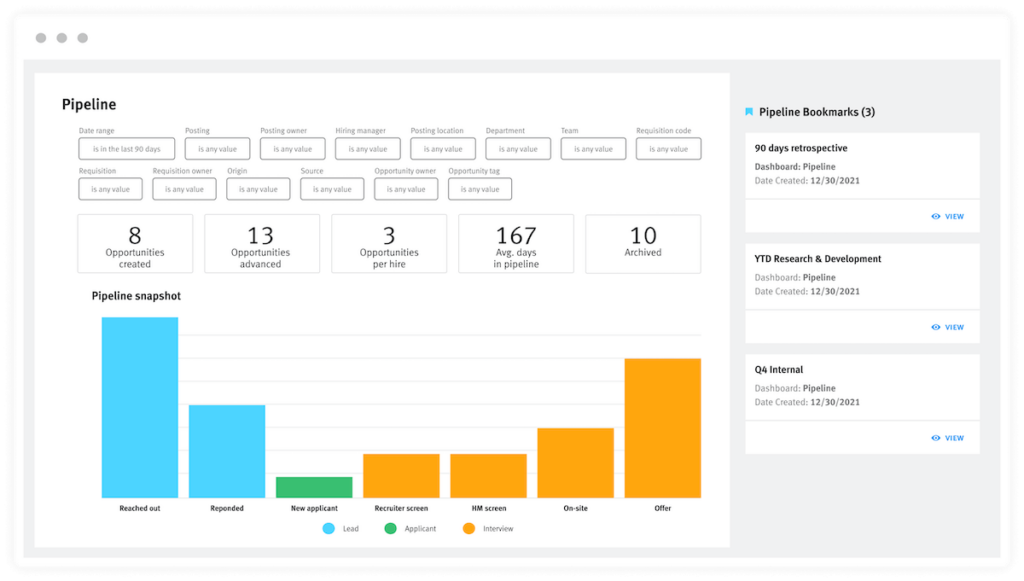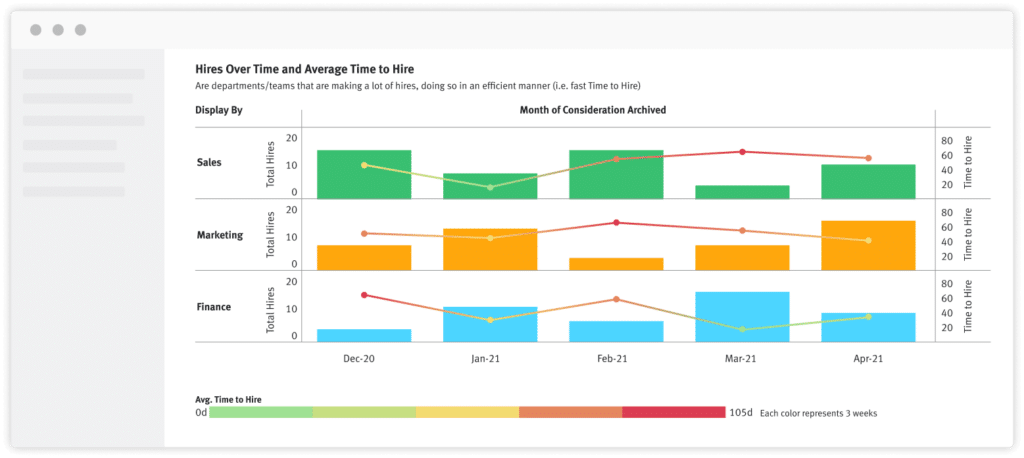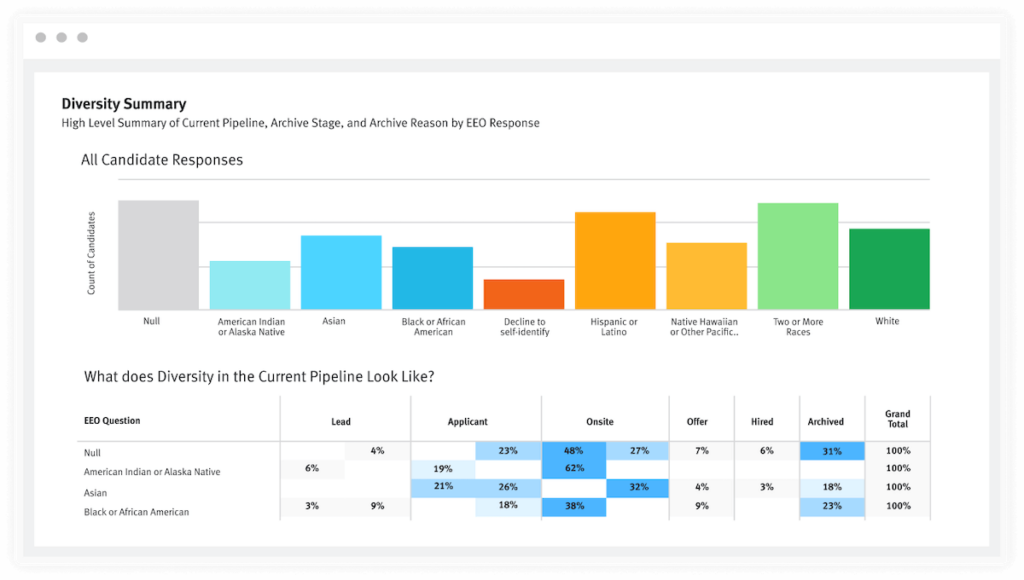The days of depending on disparate analytics tools — each with its own distinct hiring dashboard that (more often that not) doesn’t share essential data with other talent acquisition and human resources tech — are over.
Today, the top TA strategies that lead to smarter and better hiring decision-making revolve around a centralized, easy-to-use talent analytics solution.
More to the point, those strategies are built around a complete ATS + CRM with out-of-the-box analytics that provide not just a dedicated hiring dashboard for you talent director to use, but also niche dashboards for each talent acquisition and hiring team member to leverage.

10 hiring dashboards that help LeverTRM users evaluate and improve their recruitment process
In addition to creating personalized nurtures and streamlining their sourcing efforts, LeverTRM users also sue Visual Insights to both assess their talent acquisition activities with ease and refine their recruitment metrics (e.g., time to fill, applications via job postings) over time.
Put plainly, Visual Insights enables and empowers talent teams of all sizes to easily tracking key performance indicators (KPIs) assigned to them by their TA leaders, track qualified candidates as they move throughout the recruitment funnel, and make progress with core metrics.
And these 10 helpful hiring dashboards within Visual Insights are ones that offer a wealth of useful and actionable talent acquisition insights for Lever customers and ensure they continually improve their hiring funnel efficiency and overall TA team productivity.
1) Overview
Starting their mornings off with with a glimpse into their high-level recruitment metrics and ongoing activities in this dashboard helps Lever customers quickly discern how they’re performing in terms of pipeline progress.
For instance, LeverTRM users can see the total number of days requisitions have been live, since job postings have been published, and since the most recent engagement with active and passive candidates of interest.
2) Requisitions
Talent leaders and hiring managers both benefit from this insightful hiring dashboard.
Being on the same page regarding how many reqs remain open and have closed in a given time period as well as which ones are assigned to which recruiter helps all key stakeholders ensure a smooth hiring process.
The dashboard also helps with monitoring recruiters’ progress with filling open positions and meeting headcount goals laid out by leadership (from annual workforce planning sessions and adjustments made due to changing external factors, like weakening economic conditions).
3) Pipeline
Aside from getting a real-time pipeline “snapshot,” talent teams with LeverTRM can also learn how to better manage their pipeline, more seamlessly move prospects through the funnel, and deliver a top-tier candidate experience (CX).
Average days in pipeline, total opportunities created and advanced, production by opp owner: Talent directors, specialists, and operations managers alike can see a wide range of pertinent data points at a glance in this hiring dashboard.

4) Postings
Whether you want to see long-active and recently closed listings or gauge time to hire and offer acceptance by posting, this hiring dashboard can help you keep tabs on all roles.
Drill down further, and you can see which roles take the shortest and longest to fill by team and the average length of time applicants for each position spend in each recruiting stage.
5) Sources
Not all job boards and career communities generate the same quantity and quality of prospective candidate hires. That’s why recruiters must review their sourcing avenues often.
Strong sources (i.e., those that lead to a sizable volume of candidates whose qualifications match active roles and appeal to HMs) can be doubled down on. Meanwhile, less fruitful sources can be turned to less often (or not at all).

6) Offers
Which offers been extended and accepted in the last month? How many revisions have there been to offers made during that time? What’s the average amount of time it takes late-stage prospects to accept a job offer?
This hiring dashboard (essentially, an HR dashboard) is highly valuable, as it provides talent teams and human resources practitioners insight into offer volume, new hires for specific roles, and overall recruiter performance (i.e., how often candidates turn into new employees).
7) Interviews
You can’t provide a best-in-class CX if you don’t regularly analyze interview data.
This recruitment dashboard shows which interviewers provide the most positive and negative candidate feedback, their average time to provide feedback, how long it takes them to complete interviews, and how many interviews are conducted in a given time frame.

8) Nurtures
Marketers A/B test communications with leads. Recruiters with LeverTRM do the same.
As they test automated outreach, LeverTRM users also use this dashboard to see which nurtures hit the mark (i.e., moves many prospects to the interview stage) and which don’t. It’s the latter they fix (i.e., new messaging, schedules, and/or cadences) to gradually improve.
9) Compliance
There are many regulations by which recruiters must abide. Thankfully, TA teams with LeverTRM can capably track their efforts to maintain compliance with certain measures.
Specifically, they can see all candidate-submitted data requests (e.g., opt-out via GDPR consent links, unsubscribe requests for recruiting emails) and related info (e.g., how long it takes to close them) in this dashboard.
10) EEO/DEI
Diversity, equity, and inclusion (DEI) is top of mind with countless orgs today.
These companies can’t realize more equitable and inclusive hiring practices, though, without knowing the demographics for leads in their pipeline: actively sourced/engaged prospects, archived talent, and recently made hires.
These two Visual Insights dashboards helps LeverTRM users achieve just that. They can then use this EEO survey data to inform changes to their recruiting and hiring efforts.
Download our eBook to learn how Lever customers use the customizable hiring dashboards available in LeverTRM to build smarter, data-driven recruitment strategies.



